This. Watch. Now.
Chris Nolan’s Interstellar, in theaters November 7. Visit the (also very cool) movie site here.
This. Watch. Now.
Chris Nolan’s Interstellar, in theaters November 7. Visit the (also very cool) movie site here.
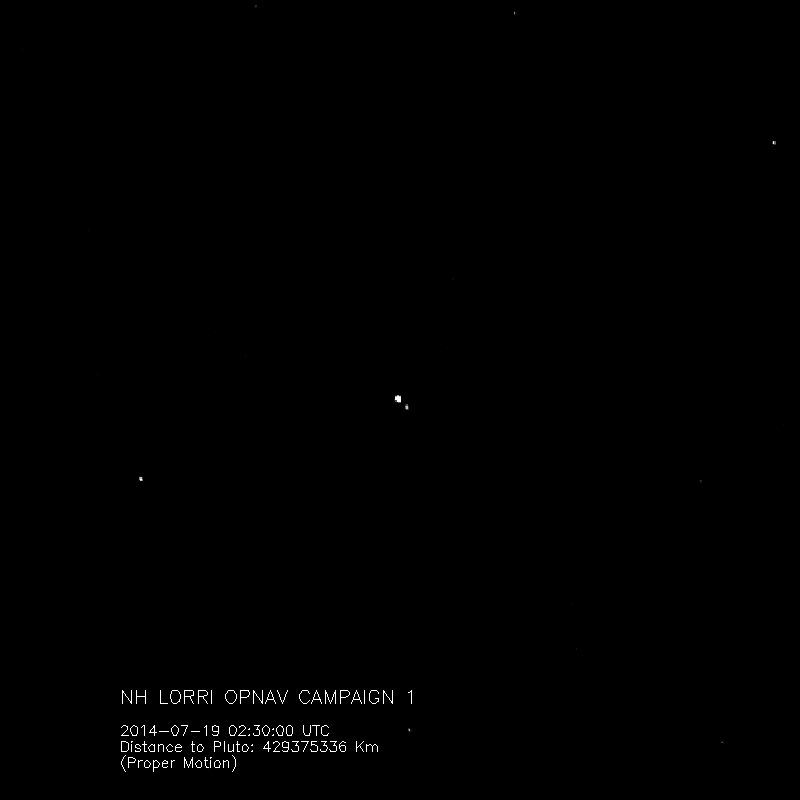
Now here’s something I guarantee you’ve never seen before: a video of the dwarf planet Pluto and its largest moon Charon showing the two distinctly separate worlds actually in motion around each other! Captured by the steadily-approaching New Horizons spacecraft from July 19–24, the 12 images that comprise this animation were acquired with the Long Range Reconnaissance Imager (LORRI) instrument from distances of 267 million to 262 million miles (429 million to 422 million km) and show nearly a full orbital rotation. Absolutely beautiful!
For a close-up video of the two worlds in motion, click below:
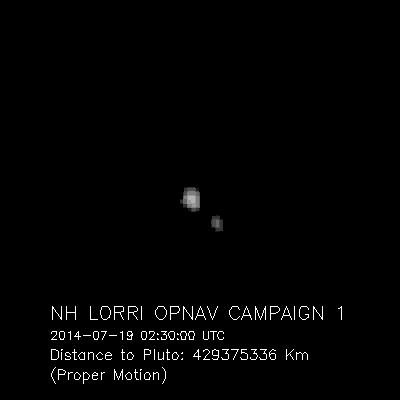
Pluto and Charon are seen circling a central gravitational point known as the barycenter, which accounts for the wobbling motion. Since Charon is 1/12th the mass of Pluto the center of mass between the two actually lies a bit outside Pluto’s radius, making their little gravitational “dance” readily apparent.
(The same effect happens with the Earth and Moon too, but since the barycenter lies 1,700 km below Earth’s surface it’s not nearly as obvious.)
“The image sequence showing Charon revolving around Pluto set a record for close range imaging of Pluto—they were taken from 10 times closer to the planet than the Earth is,” said New Horizons mission Principal Investigator Alan Stern, of the Southwest Research Institute. “But we’ll smash that record again and again, starting in January, as approach operations begin.”
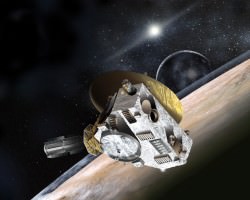
Launched January 19, 2006, New Horizons is now in the final year of its journey to the Pluto system. On August 25 it will pass the orbit of Neptune – which, coincidentally, is 25 years to the day after Voyager 2’s closest approach – and then it’s on to Pluto and Charon, which New Horizons will become the first spacecraft to fly by on July 14, 2015, at distances of 10,000 and 27,000 km respectively. Find out where New Horizons is right now here.
Source: New Horizons
Credit: NASA/Johns Hopkins University Applied Physics Laboratory/Southwest Research Institute

On December 14, 1972, at about 5:40 a.m. GMT, Apollo 17 astronaut Eugene Andrew “Gene” Cernan returned to the lunar module Challenger after the end of the third mission EVA to join Harrison “Jack” Schmitt, completing nearly two and a half days of surface operations within the Taurus-Littrow site and officially becoming the last human to set foot upon the lunar surface. No one has returned since, and to this day the 80-year-old Cernan still holds the title of “last man on the Moon.”
If that’s not the perfect setup for a documentary film, I don’t know what is. Luckily for us there’s one in the works.
“The Last Man on the Moon,” from UK-based Mark Stewart Productions, tells the story of Gene Cernan and his accomplishments against the backdrop of the Apollo era, when superpowers competed for dominance in space and hotshot flyboys became international heroes. With firsthand accounts from Cernan himself and his family, along with several other astronauts and NASA celebrities, it’s an emotional and intimate account of America’s last lunar voyage.
Watch the trailer below:
According to IMDB the 99-minute documentary directed by Mark Craig is slated for release in the UK (and hopefully U.S.!) sometime this year, although an exact date isn’t listed. There have been advance screenings very recently, at some of which Cernan was present for Q&A sessions. Some viewers are calling it “the best space documentary they have seen” so needless to say I’m pretty excited about it!
You can keep up with the status of the film (and see some exclusive astronaut photos) by liking the Facebook page here and joining the mailing list on the official site.
And yes, we do need more films like this.
“I really wanted to reach out, stick it in my spacesuit and bring it home and show it to everybody: this is what it feels like.”
– Gene Cernan
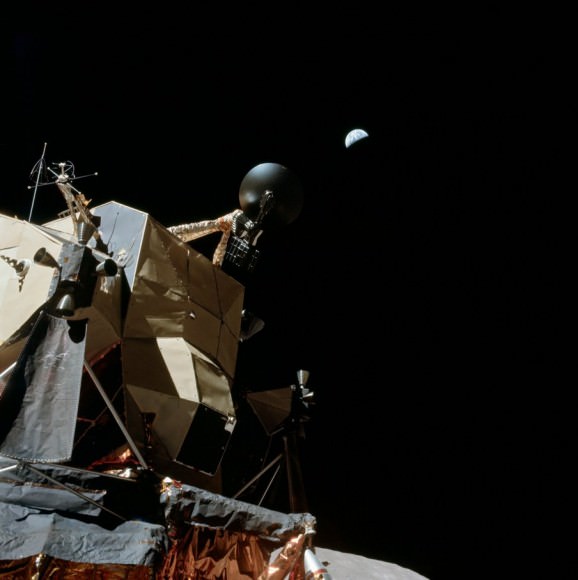
Video © Mark Stewart Productions. All rights reserved.
Christopher Nolan, the writer and director of Memento, Inception, and the most recent Batman films, is taking up space on the big screen next year — literally. Nolan’s newest film, Interstellar, will be a space exploration adventure featuring Matthew McConaughey, Jessica Chastain, Anne Hathaway, and Michael Caine (of course) and, based on this teaser trailer, maintains a reverent awareness of the iconic missions of the Space Age.
Sweet.
Continue reading “Get Teased by the New “Interstellar” Trailer”

Take a look around the Moon… no, really, take a good look AROUND the Moon! This is a fantastic animation of our planetary partner in space made by the folks on the Lunar Reconnaissance Orbiter team at Arizona State University. Assembled from reflectance maps and digital terrain models created from data gathered by LRO’s wide-angle camera, this full 360-degree portrait of the Moon shows its surface as if it were receiving direct top-down sunlight on all points — a physical impossibility, yes, but it gives us a great view of pretty much everything (including the far side, which for obvious reasons most of us never get a good look at.)
In addition to shining a light on the lunar landscape (pun intended) the vast amounts of data used to create the view above can also be used to calculate the type of illumination that would be found on any point on the Moon, at any time, allowing for better targeted observation planning with LRO’s narrow-angle camera.
Read more about how this process was engineered here, and see a more recent result of these new capabilities below:
While the image above wouldn’t have been visible from anywhere on North America on October 15, 2013 at 2 p.m. EDT, it’s what would have been seen in the night sky above Mumbai — but no international calls to India were needed, as the view could simply be generated from the LRO WAC data and a ray-tracing algorithm that plots the angles of light and shadow across the lunar terrain. Voilà — it’s Insta-Moon*!
*Some assembly required.
Read more on the Arizona State University LROC site here (and to really blow your mind, watch the high-resolution version here.)
Want to explore the Moon on your Android or iPhone? Check out our Phases of the Moon app!
I love science fiction films and I especially love it when the “science” part leans closer to fact than fiction. (Yes, I’m looking at you, Europa Report.) Now I’ve never seen an actual catastrophe in orbit (and I hope I never do) but I have to assume it’d look a whole lot like what’s happening in the upcoming film “Gravity,” opening in U.S. theaters on October 4. This full official trailer was released today.
A disaster film sure becomes a whole lot more interesting when everything is moving 18,000 miles an hour and there’s no up or down. And, of course, space. (!!!)
So what do you think? Will you be seeing Gravity? Share your thoughts in the comments…
Continue reading “The Scariest Part of “Gravity” is the Lack Thereof”
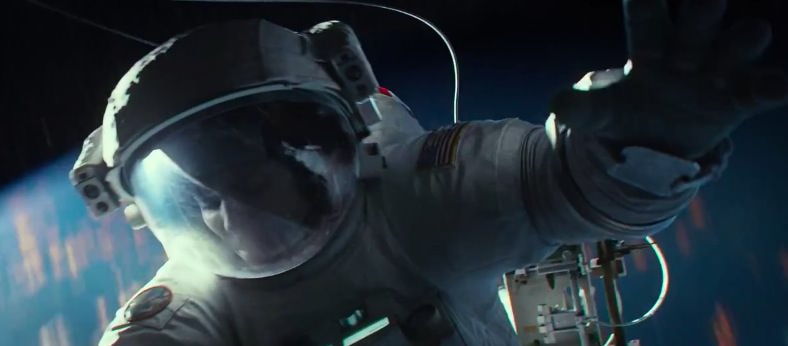
If you’ve ever been involved in one, you know that even a minor vehicle accident is a confusing and scary event. Trying to desperately regain control of your own movement as you’re suddenly subjected to forces beyond your control is stressful and terrifying… now imagine it happening at 17,500 mph and 230 miles up and you’ve got an idea of what the upcoming film “Gravity” is about.
Still can’t quite picture it? Check out the latest trailer below:
Directed and written by Alfonso Cuarón and co-written with his son Jonas, “Gravity” is the story of two astronauts (played by George Clooney and Sandra Bullock) whose shuttle is destroyed by a run-in with space junk during an EVA, stranding them both in orbit.
If that wasn’t bad enough, their oxygen is running out and they have lost communication with the ground. Cast adrift in orbit, they have to figure out how to survive and get back home.
It’s like “Open Water” in space. Without the sharks. (Let’s hope things turn out better for them!)
I enjoy sci-fi and I especially enjoy when they try to get the “sci” part right. How do things move in microgravity? (Hint: really fast.) What happens when stuff smashes together? What would happen to the human body in that situation? And, most importantly for any movie, how do the people involved handle the experience?
Above all, “Gravity” is still a movie so it has to take us on a two-hour, candy-munching, soda-slurping ride. Based on this latest trailer, I’m confident that they’ve done their homework on the mechanics of movement in orbit… now let’s see if Cuarón (Children of Men, Y Tu Mamá También, Harry Potter and the Prisoner of Azkaban) has once again worked his storytelling magic to bring the characters to free-falling life.
A Warner Bros. Pictures production, “Gravity” will be released in IMAX 3D and 2D this October. See the official movie site here.
ADDED 7/25: Here’s a new clip, titled “I’ve Got You”:
Video ©2013 Warner Bros. Entertainment. All rights reserved.
It’s been 9 years (to the day, in fact) since the Cassini spacecraft first entered orbit around Saturn and ever since it has been sending a steady stream of incredible images from the ringed planet back to Earth, bridging the 900-million-mile distance with countless wonders and groundbreaking discoveries. The views Cassini has provided us of Saturn and its family of moons are unparalleled and unprecedented, but something one could remain in want of is the element of motion: Cassini’s cameras are designed to capture still images, not true video, and thus most of our best views of Saturn are static shots.
That’s where filmmaker Stephen van Vuuren and his current project, “In Saturn’s Rings,” comes in.
An award-winning filmmaker, musician, and photographer (and self-confessed übergeek) from South Africa, Stephen van Vuuren has spent the last several years compiling hundreds of thousands of images acquired by Cassini — as well as other exploration spacecraft — into a single high-definition feature film, one that will allow viewers to experience the beauty, grandeur, and reality of the Solar System like never before.
“In Saturn’s Rings” (formerly “Outside In”) is slated for release in IMAX theaters, planetariums, and museums in the spring of 2014 — and the first official teaser trailer is below, released today. Check it out (or visit the YouTube page to watch in original, eye-melting 4k high-resolution):
“‘In Saturn’s Rings’ is a film that’s both personal and universal, experimental and sincere, science and spirit , non-narrative and documentary. The goal is to use large screen imagery, synchronized to powerful but moving music, to create an experience for those who see it, hear it and feel it.”
– “In Saturn’s Rings” official website
This is one film that I’ll be eagerly looking forward to over the next few months, without a doubt!
Read more on van Vuuren’s official film site here, and check out a full minute of film footage (originally released in 2011) on Vimeo here. Also, you can keep up with updates on the movie’s Twitter and Facebook pages.
Here’s one bit of NASA outreach that won’t be affected by suspensions or sequesters: an edited version of “We Are The Explorers,” a video highlighting the past successes and future goals of the space administration — created by NASA and featuring an inspiring narration by Peter “Optimus Prime” Cullen — will be screened in several major U.S. cities during the premiere of Star Trek Into Darkness thanks to an overwhelmingly successful crowdfunding effort on Indiegogo.com.
Now that the initial goal of $33,000 has been met and the 30-second ad spot can be purchased, the team responsible for the campaign (Aerospace Industries Association of America) will use any funds donated during the next 29 days to reach its next target: getting the ad in at least one theater in every state in America for two weeks. In order for that to happen, a grand total of $94,000 will need to be reached.
Want to help make it so? Find out more about how you can contribute:
According to the Indiegogo campaign page, “If we raise our funding total to $94,000, students, young people, and the general public will see this video from coast to coast. This new goal will expand our reach from 59 movie theater screens to 750 screens!”
That means a lot more chances that the spot will run at the theater where you go to see the new Star Trek film when it comes out on May 17. (Because you know you’re going to go see it, let’s be honest. It’s Star Trek.)
And because it’s Indiegogo you’ll get a “perk” depending on the amount you contribute, ranging from digital copies of the final spot to DVD copies of the excellent HBO series “From Earth to the Moon” (while supplies last.) Because the initial goal has been met, some perks are already sold out… but then, contributing to something as important as space exploration isn’t about the stuff you get, it’s about the message you can give.
“This is more than a fundraiser, it’s a demonstration of support for space exploration programs. By donating to this campaign, you’re making a very powerful statement about the widespread enthusiam that exists for space programs. A crowdfunding campaign is the best vehicle to deliver this message. By reaching our goal, we not only enable a first-of-its-kind ad campaign, we also demonstrate that countless people support a strong space program that’s in development.”
You can contribute here, and be sure to spread the word too. That way, when you’re looking at the video on the big screen, when you see them putting Al Shepard’s gloves on, when you see the fiery exhaust of the Saturn rocket and you hear Cullen’s voice rumble “we are the explorers,” you can know that you helped make it happen — and that somewhere in that same theater a young mind may very well be inspired to continue the exploration.
Maybe that mind might even be be your own.
“Our next destination awaits. We don’t know what new discoveries lie ahead, but this is the very reason we must go.“
This crowdfunding campaign is the work of the Aerospace Industries Association (AIA) of America. This campaign is not endorsed by NASA nor is it conducted at their direction or request. Note: by donating you acknowledge that donations are not tax deductible.
Stranded on an alien planet, ejected from your burning ship and with only minutes of breathable air left, your chances of survival look slim indeed. And with — something — tearing holes in your suit, you’ll likely be dead before you know it.
That is, of course, unless you have a good narrator.
“Voice Over,” a short film directed by Martin Rosete, puts you in this and a couple other similarly precarious situations, each seemingly bleaker than the last. Through it all a narration by Feodor Atkine underscores the hopelessness (in French, with subtitles) until the final reveal, which… well, I won’t spoil it for you. All I’ll say is it’s well worth 9 minutes of your time.
Watch the video below.
(Quick warning: a couple of parts are slightly graphic.)
I must say, I couldn’t help but feel like I was watching a film version of a Choose Your Own Adventure book.
Voice Over
Starring Jonathan D. Mellor and Feodor Atkine
Directed by Martin Rosete
Produced by Koldo Zuazua, Sebastian Alvarez, Manuel Calvo, and The Rosete Brothers
Cinematography by Jose Martin Rosete
From Kamel Films
h/t to io9.com